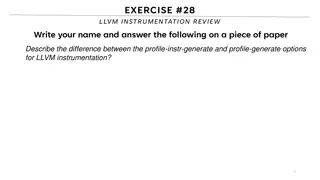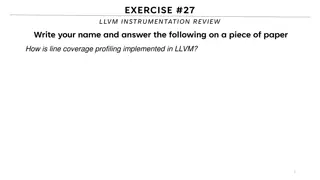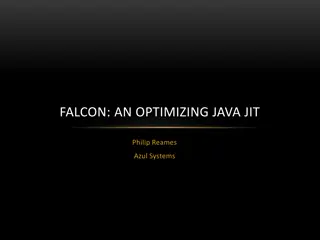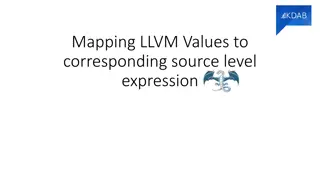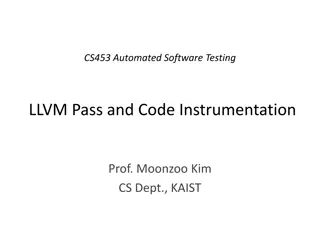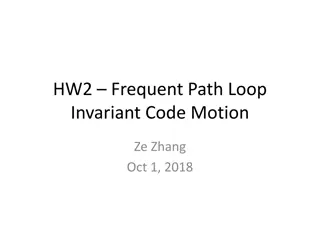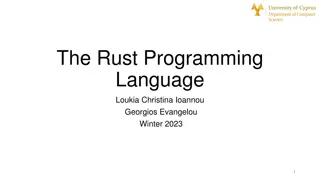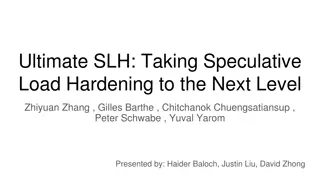
Comparison of Clang and LLVM: Pros and Use Cases
Explore the differences and advantages of Clang and LLVM in terms of source code information availability, transformation capabilities, and language independence. Discover use cases for developing checkers and run-time checkers in C and C++ using Clang and LLVM.
Download Presentation

Please find below an Image/Link to download the presentation.
The content on the website is provided AS IS for your information and personal use only. It may not be sold, licensed, or shared on other websites without obtaining consent from the author. If you encounter any issues during the download, it is possible that the publisher has removed the file from their server.
You are allowed to download the files provided on this website for personal or commercial use, subject to the condition that they are used lawfully. All files are the property of their respective owners.
The content on the website is provided AS IS for your information and personal use only. It may not be sold, licensed, or shared on other websites without obtaining consent from the author.
E N D
Presentation Transcript
Clang v.s. LLVM Moonzoo Kim Software Testing and Verificaton (SWTV) group CS Dept. KAIST 2025-04-13 1
Comparison of Clang and LLVM Clang LLVM Pros Source code information (e.g., line/column number) is available Clang supports source-to-source transformation Complex high-level language semantics are lowered to relatively simple instructions An analysis tool using LLVM can be programming language independent Cons A user should handle complex C/C++ language semantics (e.g., side effect, various AST node types) Source code information is lost Application C s undefined behavior checker Source code refactoring tool Source code browser (e.g., Source Insight) Static analyzer for bug detection Test generator Runtime monitoring tool 2025-04-13 2
An Example of Clangs Use Cases You need to use Clang to develop a checker for C/C++ s undefined behaviors in source code Undefined behaviors in C code will be removed in transformed LLVM IR Line 4 of C code containing an undefined behavior is transformed into well-defined LLVM instructions LLVM bytecode (Simplified version) 1 define i32 @example() { 2 store i32 1, i32* %a 3 %1 = load i32* %a 4 %2 = add i32 %1, 1 5 store i32 %2, i32* %a 6 %3 = load i32* %a 7 %4 = add i32 %3, 1 8 store i32 %4, i32* %a 9 %5 = add i32 %1, %4 10 store i32 %5, i32* %b 11 %6 = load i32* %b 12 ret i32 %6 } C code 1 int example(){ 2 int a = 1, b; 3 // Undefined behavior 4 b = a++ + ++a; 5 return b;} 2025-04-13 3
An Example of LLVMs Use Cases (1/3) Using LLVM to develop a run-time checker by inserting assertions is easier than using Clang When we use Clang for analyzing C source code, we need to handle C s complex language semantics including side effects Suppose that we would like to do array bound checking by inserting assert() before array accesses One possible solution is to use Clang to insert assert() to check array subscription expression can be greater than the size of array An instrumented program 1 int example(int *a,int x){ 2 int b[10]; 3 omitted code 4 assert(++a[x++]<10); 5 b[++a[x++]]=0; 6 } An example program 1 int example(int x){ 2 int a[10], b[10]; 3 omitted code 4 // Want to check array bound 5 b[++a[x++]]=0; 6 } Will it Okay? 2025-04-13 4
An Example of LLVMs Use Cases (2/3) The array subscription expression ++a[x++] has side effects Executing assert(++a[x++]) changes the value of x and a[x] We should execute the array subscription expression once and store the result to use both assert() and array access In addition, we should do array bound check for the array subscription expression ++a[x++] itself. If we choose Clang to develop a run-time checker to insert assert(), we should consider such complex semantics of C program code An instrumented program rev. 2 1 int example(int *a,int x){ 2 int b[10]; 3 omitted code 4 int tmp1=x++; 5 assert(tmp1<10); 6 int tmp2=++a[tmp1] 7 assert(tmp2<10); 9 b[tmp2]=0; 10 } An example program 1 int example(int x){ 2 int a[10], b[10]; 3 omitted code 4 // Want to check array bound 5 b[++a[x++]]=0; 6 } 2025-04-13 5
An Example of LLVMs Use Cases (3/3) If we use LLVM to perform array bound check, we can simply instrument the getelementptrinstruction (LLVM instruction for array accesses) to check the 3rdparameter (array index) of the instruction We do not suffer side effects because all side effects in C code are removed by LLVM front-end LLVM bytecode (Simplified version) 1 define i32 @example(i32 %x) { 2 %1 = alloca i32 3 %a = alloca [10 x i32] 4 %b = alloca [10 x i32] omitted code 9 %4 = sext i32 %2 to i64 10 %5 = getelementptr [10 x i32]* %a, i32 0, i64 %4 ; access to array a[10] omitted code 14 %8 = sext i32 %7 to i64 15 %9 = getelementptr [10 x i32]* %b, i32 0, i64 %8 ; access to array b[10] An example program 1 int example(int *a,int x){ 2 int b[10]; 3 // Want to check array bound 4 b[++a[x++]]=0; 5 } 2025-04-13 6




